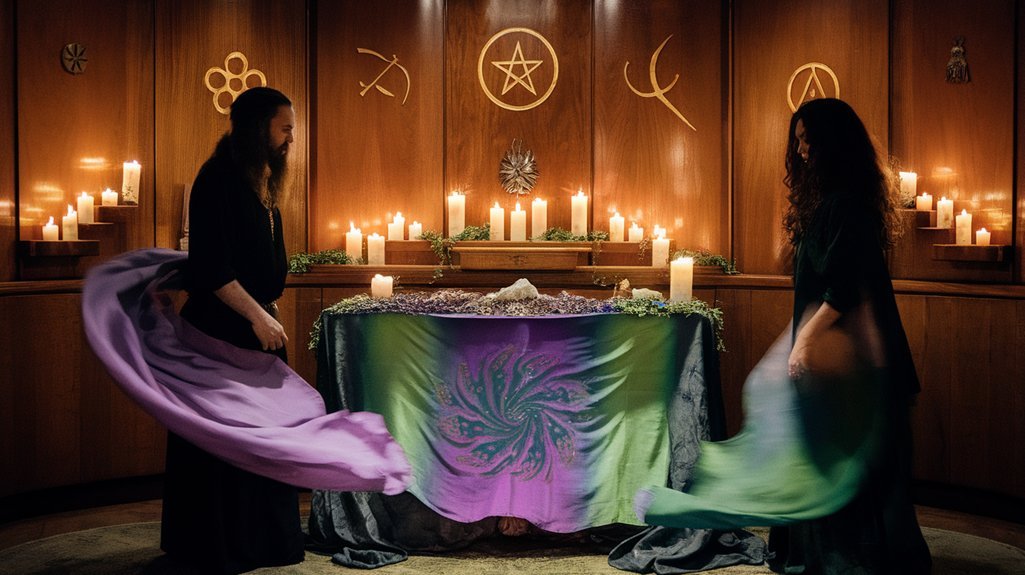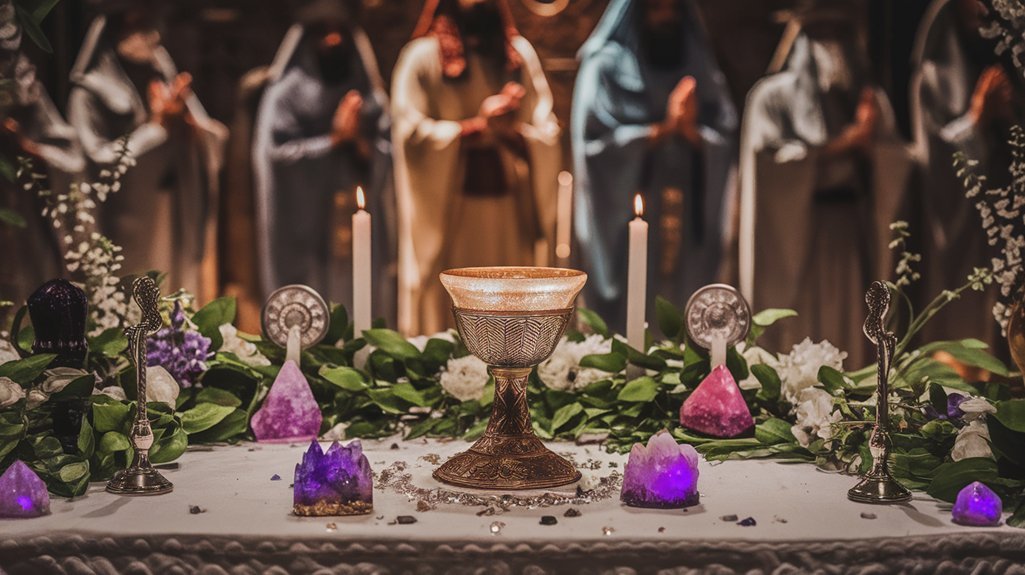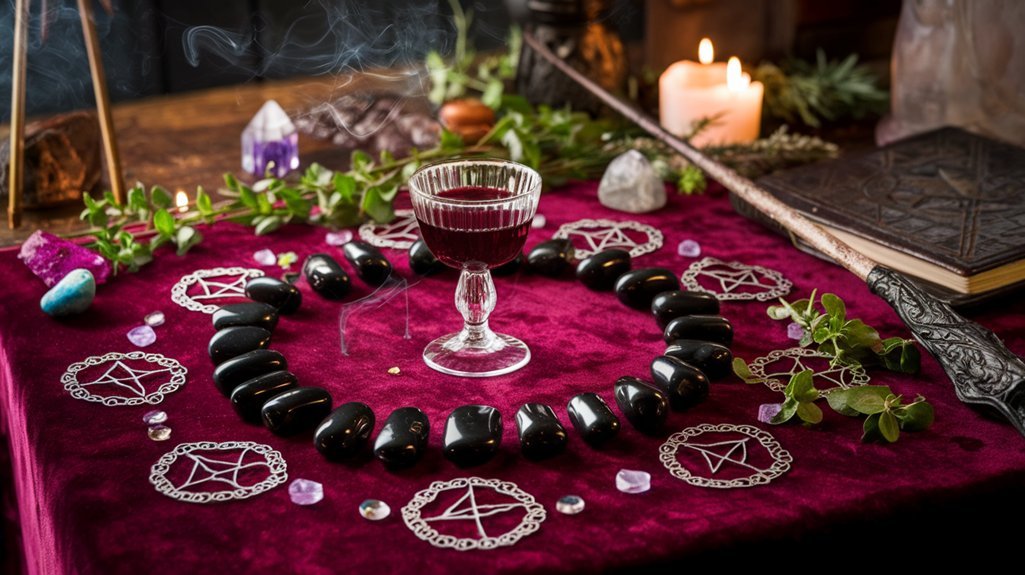As an Amazon Associate I earn from qualifying purchases.
You might find Alexandrian Mystique intriguing as it unpacks the ceremonial layers of modern Wicca. This tradition, deeply influenced by Gerald Gardner, was innovated by Alex and Maxine Sanders, emphasizing rich symbolism and gender balance. As you explore its structured rituals and seasonal celebrations, you'll notice how it intertwines ancient wisdom with contemporary values. Discover how this evolving practice fosters a profound connection with the divine, ensuring its relevance for future generations.
Key Takeaways
- Alexandrian Wicca integrates ancient pagan influences with modern ritual innovations to create a rich ceremonial practice.
- Founders Alex and Maxine Sanders emphasized gender balance and ceremonial depth in Wiccan rituals.
- Rituals involve casting circles, calling quarters, and invoking deities to create sacred spaces for spiritual engagement.
- Essential ritual tools, such as athames and chalices, carry symbolic meanings to enhance spiritual intentions.
- Modern adaptations and digital platforms support community engagement, inclusivity, and the evolution of Wiccan traditions.
Origins of Alexandrian Wicca

Although the roots of Alexandrian Wicca date back to the mid-20th century, they significantly draw upon ancient pagan traditions and mystical practices. You'll find that its foundational beliefs are deeply intertwined with historical context and cultural influences from ancient Egyptian and Greco-Roman traditions. Early practitioners, such as Alex Sanders and Maxine Sanders, played crucial roles in shaping its doctrines and rituals. Sacred texts, while not as formalized as in other religions, often include adapted versions of older pagan writings, enriched by regional variations that reflect the diversity within the practice.
Community dynamics in Alexandrian Wicca emphasize coven-based learning and the sharing of knowledge, although contemporary adaptations have led to more solitary practices. You'll notice that these adaptations allow for flexibility, ensuring the tradition remains relevant in modern contexts. Understanding these origins provides a clear lens through which to appreciate the complexity and depth of Alexandrian Wicca today.
The Influence of Gerald Gardner
The exploration of Alexandrian Wicca's origins naturally leads to the significant role played by Gerald Gardner in the broader Wiccan movement. His influence is undeniable within Wiccan history, providing foundational elements that shaped subsequent traditions. You'll notice how Gardnerian influence permeates through ritual adaptations and ceremonial practices, offering a spiritual lineage that deeply impacts modern interpretations of Wicca.
Gardner's contributions laid the groundwork for a structured approach, emphasizing ritualistic precision. His ceremonial practices offered a framework later adapted by Alexandrian Wicca, fostering a nuanced blend of tradition and innovation. The table below outlines key aspects of Gardner's influence:
| Aspect | Description |
|---|---|
| Gardnerian Influence | Foundational to Wiccan traditions |
| Wiccan History | Pivotal in structuring modern practices |
| Ritual Adaptations | Enabled tailored ceremonial approaches |
| Modern Interpretations | Influenced evolving spiritual perspectives |
| Spiritual Lineage | Established continuity in Wiccan traditions |
This influence underscores the complexity and richness of Wicca as it continues to evolve.
The Role of Alex and Maxine Sanders

As you delve into the role of Alex and Maxine Sanders in the evolution of Wicca, it becomes clear that their contributions were both transformative and controversial. Their Sanders Influence reshaped Wiccan rituals and introduced Ritual Innovations that set the Alexandrian tradition apart. Through Crafting Practices, they emphasized ceremonial elements, enriching the spiritual experience. The duo's impact on Community Dynamics fostered a more open, inclusive environment, while their Teaching Methods focused on rigorous training and practical application. By challenging traditional Gender Perspectives, they promoted equality and balance within rituals and covens. Their Modern Adaptations of Wiccan practices ensured relevance in contemporary society, maintaining Ethical Practices in their teachings. Their Personal Journeys became a narrative of devotion and exploration, leaving Legacy Contributions that continue to influence today's practitioners.
- Emphasized ceremonial richness
- Promoted gender equality in rituals
- Fostered inclusive community dynamics
- Pioneered modern practice adaptations
- Left a lasting legacy in Wicca
Key Principles of Alexandrian Practice
When examining Alexandrian Wicca, you should consider its structured ritual framework and the rich symbolism that accompanies it. These rituals often involve detailed ceremonial elements that emphasize the sacred through specific symbols and actions. Additionally, you'll notice a strong focus on deity worship and invocation, where practitioners engage deeply with divine energies to enhance spiritual experiences.
Ritual Structure and Symbolism
Rituals in Alexandrian Wicca, rich with symbolism and structured precision, serve as a conduit to the divine and a method of spiritual expression. They're crafted with intricate ritual dynamics and symbolic meanings that facilitate a deeper connection to spiritual forces. You'll find that each element of the ritual has a purpose, from the tools used to the words spoken.
Consider these components:
- Circle Casting: Marks sacred space, representing infinity and protection.
- Elemental Invocations: Calls upon earth, air, fire, and water, symbolizing balance.
- Altar Setup: Arranged with ritual tools, each signifying different aspects of Wiccan practice.
- Chants and Incantations: Use of spoken words to channel energy and intention.
- Ritual Garb: Clothing that reflects spiritual focus and tradition.
Understanding these elements allows for a comprehensive appreciation of Alexandrian practices.
Deity Worship and Invocation
Though often rooted in ancient traditions, deity worship and invocation in Alexandrian Wicca emphasize a personal and dynamic relationship with the divine. By engaging in ritual invocation, you open pathways for divine communication, using sacred names and invocation chants to connect with patron deities. This practice involves both goddess worship and exploring god archetypes, ensuring a balanced spiritual alignment. Deity offerings act as a bridge, enhancing energy channeling between you and the divine forces. Here's a detailed breakdown:
| Aspect | Purpose | Methodology |
|---|---|---|
| Deity Offerings | Bridge to the divine | Gifts, libations |
| Ritual Invocation | Initiate divine presence | Sacred chants, names |
| Goddess Worship | Honor feminine divine aspects | Altars, moon rituals |
| God Archetypes | Explore masculine divine traits | Mythology, seasonal rites |
This structured approach fosters a profound connection with the divine.
The Significance of Rituals and Ceremonies

While exploring modern Wicca, understanding the significance of rituals and ceremonies becomes essential. Each ritual holds a specific purpose, weaving the practitioner's intentions into the fabric of spiritual practice. Ritual significance lies in its ability to create a sacred space, enabling you to connect with the divine and express personal transformation. Ceremonial purpose often involves marking transitions, honoring seasonal cycles, or invoking divine energies. By participating in these ceremonies, you solidify your connection with the natural world and reinforce communal bonds within the Wiccan community.
Consider the following elements often present in Wiccan rituals:
- Casting the Circle: Establishes a sacred boundary between the mundane and spiritual realms.
- Calling the Quarters: Invokes the energies of the four cardinal directions.
- Ritual Dance: Enhances energy flow and focus during ceremonies.
- Incantations: Spoken words that channel intentions and desires.
- Offerings: Symbolize gratitude and reciprocity with deities.
These components highlight the depth and intention behind Wiccan practices.
Tools and Symbols in Alexandrian Wicca
In Alexandrian Wicca, understanding the essential ritual tools is crucial, as each item holds significant symbolic meanings that guide practitioners during ceremonies. You'll find that tools like the athame, chalice, and pentacle are not only functional but also serve as representations of elemental forces and spiritual concepts. Crafting personal altars allows you to align these symbols with your individual spiritual journey, creating a space that reflects both tradition and personal belief.
Essential Ritual Tools
Understanding the essential ritual tools and symbols of Alexandrian Wicca unveils the profound connection between physical implements and spiritual practices. Each ceremonial tool is imbued with ritual significance, serving as a conduit for energy and intention. These tools facilitate the practitioner's journey into deeper realms of consciousness and connection with the divine. In Alexandrian Wicca, you'll likely encounter a variety of implements, each with its own specific purpose and energy.
- Athame: A double-edged dagger symbolizing authority and the element of air.
- Chalice: Represents water and is used during libations and invocations.
- Pentacle: A protective symbol that embodies earth's grounding qualities.
- Wand: Channels energy and represents the element of fire.
- Censer: Holds incense to purify the ritual space with smoke.
These tools are integral to the practice's ceremonial depth.
Symbolic Meanings Explained
Delving into the symbolic meanings of tools and symbols in Alexandrian Wicca reveals their profound impact on spiritual practice. You'll find that symbolic colors like red for passion or blue for tranquility enhance ritual intent. Sacred geometry, such as the pentagram, connects you to universal truths. Elemental correspondences, representing earth, air, fire, and water, harmonize your rituals with nature's forces. Astrological influences guide your timing and focus during rituals. Ritual gestures, like the sign of the pentacle, reinforce magical correspondences. Nature symbols, including the moon and sun, align with lunar phases to mark spiritual cycles. Mythological references ground your practice in historical context. Personal symbolism allows you to infuse individual meaning, enriching your spiritual journey.
Crafting Personal Altars
Why do personal altars hold such significance in Alexandrian Wicca? They serve as a focal point for spiritual practice, embodying the practitioner's connection to the divine. Altar personalization allows you to create a sacred space that resonates with your spiritual journey. In Alexandrian Wicca, each tool and symbol on your altar holds specific meanings, enriching your ritual experience. As you craft your altar, consider these elements:
- Candles: Representing divine light and intention.
- Athame: Symbolizing focus and willpower.
- Chalice: Embodying the element of water and emotions.
- Pentacle: Offering protection and grounding.
- Incense: Enhancing the atmosphere and invoking spirit.
Understanding these components helps you design an altar that truly reflects your path, fostering a deeper connection to your sacred space.
The Structure of Coven Initiations
In the realm of modern Wicca, the structure of coven initiations is a carefully orchestrated process that reflects the intricate blend of tradition and personal growth. You'll find that initiation ceremonies serve as a gateway into the coven hierarchy, marking a significant step in a practitioner's spiritual journey. These ceremonies are not mere formalities; they're designed to align the initiate with the coven's collective energy and ethos. Each initiation is tailored to reflect both the coven's established practices and the individual's unique path.
Understanding the coven hierarchy is crucial as it dictates the roles and responsibilities within the group. Typically, you'll encounter a structured progression—often divided into degrees—where initiates advance through demonstrated commitment and mastery of Wiccan practices. This progression ensures that each member contributes meaningfully to the coven, creating a balanced community. Initiations, therefore, are foundational, fostering both personal and collective spiritual development.
Deities and Divine Archetypes

Although understanding Wiccan deities and divine archetypes can be complex, it is essential for grasping the spiritual framework that underpins modern Wicca. The tradition embraces a pantheon diversity, allowing practitioners to connect with a range of archetypal energies. Goddess worship is central, highlighting sacred femininity, while masculine archetypes balance the spiritual embodiment. The god symbolism often interweaves with mythological influences, offering a tapestry rich with narrative depth.
To paint a clearer picture:
- Divine connection: Facilitates personal and communal spiritual growth.
- Archetypal energies: Represent fundamental human experiences.
- Goddess worship: Celebrates the nurturing and creative forces.
- God symbolism: Encompasses strength and protection.
- Seasonal deities: Reflect the cyclical nature of life and the earth's rhythms.
This framework encourages a holistic understanding of existence, where the divine mirrors the human journey, fostering a connection that transcends the mundane.
Seasonal Celebrations and Sabbats
As you explore the rich tapestry of Wiccan traditions, the role of seasonal celebrations and Sabbats becomes undeniably significant. These ceremonies provide structure and rhythm to the spiritual year, each marking the seasonal significance of Earth's cycles. The Wheel of the Year, comprising eight Sabbat celebrations, reflects a deep connection with nature's ebb and flow.
You'll find that each Sabbat, whether it's Samhain, Yule, or Beltane, embodies unique themes and energies tied to specific times of the year. This alignment with nature fosters a greater awareness of your environment and personal growth. During these celebrations, practitioners often engage in rituals, ceremonies, and communal gatherings, emphasizing gratitude, renewal, and balance.
The Evolution of Alexandrian Traditions

While exploring the diverse branches of modern Wicca, the evolution of Alexandrian traditions highlights both adaptation and preservation. You notice how these traditions have adjusted to meet the needs of their practitioners while maintaining core principles. Tradition adaptations in Alexandrian Wicca reflect a balance between innovation and continuity, ensuring rituals remain relevant yet rooted in their origins. Community dynamics play a crucial role in shaping these changes, as members collectively decide how to interpret and implement practices.
Consider these elements of evolution:
- Ritual Structure: Adapts to reflect contemporary social and cultural values.
- Inclusivity: Emphasizes broader participation, welcoming diverse backgrounds.
- Technological Integration: Utilizes digital platforms for global connectivity.
- Eclectic Influences: Incorporates elements from other spiritual paths.
- Leadership Styles: Shifts towards more democratic and cooperative models.
These aspects illustrate how Alexandrian traditions remain dynamic, fostering a vibrant and evolving spiritual community.
Integrating Magic and Spirituality
You'll find that integrating magic and spirituality in Wicca often relies on sacred ritual practices that provide structure and intention. These rituals frequently incorporate symbolic tools, each carrying specific meanings that enhance the practitioner's spiritual connection. By understanding the significance and application of these tools, you can effectively bridge the gap between the physical and spiritual realms.
Sacred Ritual Practices
In modern Wicca, sacred ritual practices serve as a profound bridge between magic and spirituality, harmoniously blending the two into a cohesive spiritual experience. You'll find yourself in a sacred space, where every detail from ritual timing to ceremonial attire matters. The energy flow becomes palpable as you recite invocation chants, connecting deeply with the forces at play. Ritual tools are not mere objects but extensions of your intent and focus. Balancing communal rituals with personal devotion allows you to connect with both community and self.
- Sacred space: A dedicated area enhancing focus and intention.
- Ritual timing: Aligning practices with lunar cycles or seasonal events.
- Ceremonial attire: Symbolic clothing that elevates spiritual engagement.
- Invocation chants: Spoken words that harness spiritual energies.
- Energy flow: The dynamic movement of mystical forces within the ritual.
Symbolic Tools Connection
Symbolic tools in modern Wicca don't just sit idly on the altar; they actively engage practitioners in the delicate dance between magic and spirituality. Each tool, whether it's an athame, chalice, or pentacle, carries distinct symbolic meanings and ritual significance. You might find that the athame represents the element of air, channeling intent and focus, while the chalice embodies water, nurturing emotions and intuition. These tools don't merely serve as physical objects; they act as conduits, aligning your spiritual energy with the universe's forces. By understanding their roles, you deepen your connection to the ritual's purpose. Integrating these tools doesn't just enhance the ceremony; it transforms the practice into a harmonious blend of the tangible and the ethereal.
Alexandrian Wicca in the Modern World
While the roots of Alexandrian Wicca trace back to the 1960s, its influence in the modern world remains significant. You'll find that the tradition has adapted to contemporary society through various means. Community involvement has increased, allowing practitioners to share rituals and knowledge. Modern adaptations integrate cultural influences, enabling a richer practice that resonates globally. The rise of online resources has expanded access, making it easier to connect with fellow Wiccans and learn about Alexandrian practices.
Interfaith dialogue improves public perception by fostering understanding and acceptance. Youth engagement ensures the continuity of traditions, while educational outreach programs demystify misconceptions.
Consider these elements shaping Alexandrian Wicca today:
- Community-driven events promote inclusivity and shared experiences.
- Digital platforms facilitate global discussions and learning.
- Cultural syncretism enhances the depth of rituals and beliefs.
- Workshops and seminars broaden educational outreach.
- Youth-led initiatives drive future growth and innovation.
These aspects collectively fortify Alexandrian Wicca's relevance in modern times.
Frequently Asked Questions
How Does Alexandrian Wicca Address Environmental Issues?
You explore eco spiritual practices in Alexandrian Wicca by engaging with rituals that emphasize nature reverence. These practices prioritize living in harmony with the Earth, encouraging actions that protect and honor the environment's sacred essence.
What Is the Role of Technology in Alexandrian Wicca Practices?
Did you know 80% of Wiccan practitioners engage in digital rituals? In Alexandrian Wicca, technology helps foster online communities, allowing you to connect, share knowledge, and participate in ceremonies, enriching your spiritual journey without geographical limitations.
Are There Dietary Guidelines or Restrictions in Alexandrian Wicca?
You don't find strict dietary guidelines in Alexandrian Wicca. However, dietary practices often align with personal beliefs and ritual offerings. You might choose symbolic foods that enhance your connection to nature and the elements during ceremonies.
How Does Alexandrian Wicca Handle Conflicts Within a Coven?
Imagine a storm clearing the sky; that's how conflict resolution works in covens. You address issues openly, focusing on group dynamics. Encouraging communication and understanding helps maintain harmony, ensuring everyone's voice is heard and respected.
Can Individuals Practice Alexandrian Wicca Without Joining a Coven?
You can practice Alexandrian Wicca individually, though it's traditionally coven-based. Personal practice allows you to adapt rituals, fostering solitary rituals that resonate with you. However, missing group dynamics might affect the traditional ceremonial depth and learning experience.
Conclusion
As you immerse yourself in Alexandrian Wicca, you'll find it's like peeling back the layers of an intricate tapestry, revealing a vibrant blend of ancient wisdom and modern sensibilities. This tradition, with its structured rituals and deep symbolism, not only honors the cycles of nature but also adapts to contemporary spiritual needs. By embracing its principles, you engage in a living practice that balances magic and spirituality, ensuring its relevance and vitality for future generations.
Amazon and the Amazon logo are trademarks of Amazon.com, Inc, or its affiliates.


